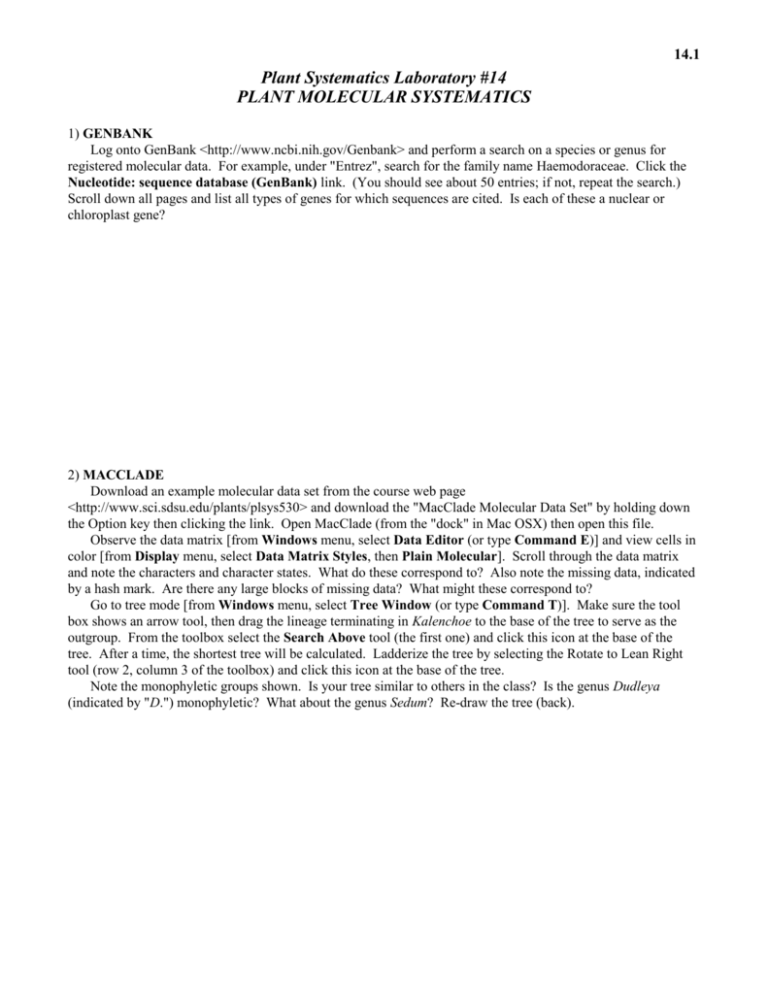Lab 14
advertisement

14.1 Plant Systematics Laboratory #14 PLANT MOLECULAR SYSTEMATICS 1) GENBANK Log onto GenBank <http://www.ncbi.nih.gov/Genbank> and perform a search on a species or genus for registered molecular data. For example, under "Entrez", search for the family name Haemodoraceae. Click the Nucleotide: sequence database (GenBank) link. (You should see about 50 entries; if not, repeat the search.) Scroll down all pages and list all types of genes for which sequences are cited. Is each of these a nuclear or chloroplast gene? 2) MACCLADE Download an example molecular data set from the course web page <http://www.sci.sdsu.edu/plants/plsys530> and download the "MacClade Molecular Data Set" by holding down the Option key then clicking the link. Open MacClade (from the "dock" in Mac OSX) then open this file. Observe the data matrix [from Windows menu, select Data Editor (or type Command E)] and view cells in color [from Display menu, select Data Matrix Styles, then Plain Molecular]. Scroll through the data matrix and note the characters and character states. What do these correspond to? Also note the missing data, indicated by a hash mark. Are there any large blocks of missing data? What might these correspond to? Go to tree mode [from Windows menu, select Tree Window (or type Command T)]. Make sure the tool box shows an arrow tool, then drag the lineage terminating in Kalenchoe to the base of the tree to serve as the outgroup. From the toolbox select the Search Above tool (the first one) and click this icon at the base of the tree. After a time, the shortest tree will be calculated. Ladderize the tree by selecting the Rotate to Lean Right tool (row 2, column 3 of the toolbox) and click this icon at the base of the tree. Note the monophyletic groups shown. Is your tree similar to others in the class? Is the genus Dudleya (indicated by "D.") monophyletic? What about the genus Sedum? Re-draw the tree (back). 14.2 3) MOLECULAR DATA MATRIX From the following data matrix, determine the informative characters and character states. Check Figure 14.6 to check your results. What do the characters and character states mean? Taxon Taxon Taxon Taxon Taxon Taxon Taxon Taxon 1 2 3 4 5 6 7 8 00000000000000000001111111111111111111111 88888888899999999990000000000111111111122 12345678901234567890123456789012345678901 GCCTAGCCAAAGCTCTTCCAAGGTGACTCTCAGTTCAAGCT GCCTAGCCAAAGCTCTTCCAAGCTGACTCTCA------GCT GCCTAGCCTAAGCTCAACCAAGGTGTCTCTCAGTTCAAGCT GCCTAGCCTAAGCTCTTCCAAGGTGTCTCTCAGTTCAAGCT GCCTAGCCAAAGCTCTTCCAAGCTGACTCTCA------GCT CCCTAGCCAAAGCTCTTCCAAGCTGACTCTCAGTTCAAGCT CCCTAGCCAAAGCTCTTCCAAGCTGACTCTCAGTTCAAGCT GCCTAGCCTAAGCTCTTCCAAGCTGACTCTCAGTTCAAGCT Informative Characters and Character States Taxon Taxon Taxon Taxon Taxon Taxon Taxon Taxon 1 2 3 4 5 6 7 8 4) RESEARCH ARTICLE Peruse a research article in plant systematics using molecular data. Answer each of the following: 1) What are the objectives of the study? 2) Read over the Materials and Methods. What gene(s) were sequenced and what is the type of DNA? 3) How many analyses were performed and on what data sets? (I.e., how were the data partitioned?) 4) What was the total number of base pairs of sequence data used, and how many of these were phylogenetically informative for: a) combined data set b) gene 1 c) gene 2 5) What is a bootstrap value and how are they determined? What is a decay index value? (see Ch2) 6) For the combined analysis tree, what is the: a) tree length?; b) CI? What do these terms mean? (Ch2) 7) Re-draw (back) the combined analysis tree, collapsing any nodes that have <70% bootstrap support.











